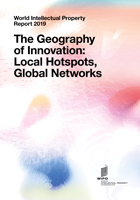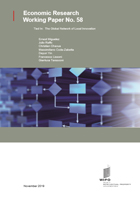Innovation Hotspots: Running on Innovation
High-growth urban areas of the world are often the same ones experiencing a fast, innovative pace. The first and second industrial revolutions saw the rising concentration of the world's wealth in Western Europe and North America. Mirroring these regions' growth is the number of their patent filings and scientific publications over the past decades. Together, patent filings and scientific publications measure the innovative activities taking place in these innovation hotspots.

Starting in the 1970's, a third industrial revolution has occurred, broadly involving digital technologies, life-science, and biological technologies. Increases in global trade and investment flows made way for the spread of knowledge creation and Innovation, making room for the rise of new players.
Patent race
The patent race shows Tokyo's dominance as a patent filer from the start. The city's massive size combined with the high density of innovative firms is the main reason for this constant patent production. However, the battle for the "best of the rest" is much more dynamic. The appearance of South Korean and Chinese clusters in the top 10 in the last 20 years displaced important western clusters such as New York, San José (Silicon Valley), and London.
Evolution of yearly patent filings by hotspot

Publication race
The scientific publication race is even more thrilling! Chinese and South Korean cities outperformed clusters from the USA, Japan, and Western Europe in the last 20 years. Beijing is currently holding the lead and widening the gap with its competitors.
Evolution of yearly scientific publications by hotspot

Values
Both patent and scientific publication data indicate that Innovation is more concentrated when it is more valuable. Our findings show that the U.S. hotspots still hold a disproportionate share of top-cited patents and scientific publications, dwarfing other economies' share. Yet, even here, there is a trend toward dispersion, where Chinese and Korean hotspots stand out.
Evolution of top cited patents and scientific publications by top economies and regions
What do you think? Will the emerging competitors also be able to catch up on this front? Which new regions will claim the next innovation hotspot with the rise of the next industrial revolution?
Other stories you may enjoy

How Policy may Redirect Innovation
Government policies can affect the rate and, to some extent, the direction of innovative activities. Some of these policies, such as R&D tax incentives, protection of intellectual property (IP) rights, encourage innovation.

Connectivity is Key
Just as people benefit from making connections in social and working environments, hotspots cross international borders to seek partners for innovation.
Related resources

The Geography of Innovation
The World Intellectual Property Report 2019 documents how the geography of innovation has evolved over the past few decades.

The Global Network of Local Innovation
In this paper we exploit a unique and rich dataset of patent applications and scientific publications...